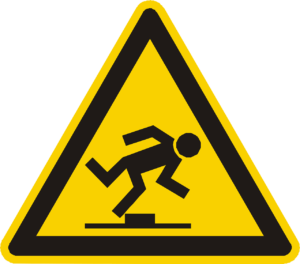In a previous paper we’ve described how the “blue pie” model illustrates the challenge of those working in human error. This challenge is that even with the entire workforce fully engaged, alert, healthy, rested and switched on they will spend 5 to 10% of their day distracted and ‘away with the fairies’. If you have, say, 10,000 workers worldwide then that’s an awful lot of ‘zombie’ time … but it’s still a risk problem to be managed even if you have just 10 staff.

Some organisations simply urge their workers to ‘pay attention’ and to look out for such as trip hazards at all times. This, especially if they’ve noted that most of their accidents are slips and trips. It’s better, however, to say: ‘in the 55 minutes you’re bright and alert, if you see a potential trip hazard stop and tidy it up, so it’s not there to trip over 30 minutes from now when you come back around the corner away with the fairies”.
This paper is about other practical techniques that are required to protect individuals from behavioural risk like trip hazards.
Mindset, habits and behaviours
Any good safety scientist wants to work up as far up the safety hierarchy as possible and we can strive for perfect design as well as perfect housekeeping. However, we can’t design out gravity and sometimes the only thing that can save an individual is a good habit.
Data shows clearly that accidents tend to occur not so much in areas of high risk but when the risk is moderate, especially when it’s also frequent. The incident will probably be caused by losing our footing/tripping, losing focus and taking our eyes and/our minds off the hazard or moving into (or not out of) the line of fire. These slips directly caused most usually by tiredness, rushing, being angry or frustrated or having simply habituated to the risk.
A classic example: tired pilots almost never crash planes on landing but once they’ve let their spouse know they’re “safely landed and in the car”, they then fall asleep at the wheel driving home from the airport. So, what should we do about these moderately dangerous but frequent risks that so often catch us out?
What can we do?
First, we need to ask the experts (IE those that do the job) ‘what do you need to be able to do this job safely?’ and action every sensible answer that’s financially viable. We should also train teams in Reason’s Cheese model, the safety hierarchy, temptation (or ABC) analysis, five why’s analysis and how to use an impact matrix. For me this must always, always be the core of a good behavioural approach.
After this we can remind people of the dangers that they might well be getting used to. My business partner, Jason Anker MBE, spends lots of time talking to experienced roofers about the on-going danger of falling because we must never forget that gravity waits patiently for just the one chance it needs and fills hospital A&E departments.
It’s true that most life taking or changing accidents would have been avoided if the person involved had taken (just) 5 seconds to stop and think.

We can also encourage employees to challenge unsafe acts in others and/or be a “brother’s keeper”. The trouble is many people find challenging others uncomfortable and many find being challenged … well really quite annoying! And anyway, often we are very comfortable taking risks especially when no-one is looking.
Coaching is arguably better than challenging as if it’s done well the person takes learning rather than indignation away from the encounter. For example, on oil rigs we can use data and illustration as part of a coaching strategy. We can point out that if the likelihood of falling down those steep, often wet, metal stairs when not holding the handrail is 100,000 to one but the stairs are used a million times a year. So if no-one holds them there will be 10 accidents give or take. If 90% hold then one accident give or take and if 99% hold them then an accident every 10 years or so and (notorious and counter-productive as it can prove as a slogan) actual “zero harm” becomes viable. Then, seeking to make a ‘sticky’ learning point, we can remind people that over the years more people have been killed off-shore in falls than in all the process safety incidents combined (Piper Alpha included).
Using data and illustration helps keep the interaction adult to adult because we all hate being wrong. Indeed, being told we’re wrong, even when we are, usually leads to denial, defensiveness and rationalisation. (And, quite often, anger, bad language and suggestions that are crude and physically impossible unless you’re a contortionist).
The very last line of defense (Beyond PPE)
In the last analysis all that can save us are good habits: Obvious examples are holding the handrail (as above), keeping a straight back when lifting, making eye contact with plant operators not assuming they can see us or wearing our PPE. (The list is endless and all fall under the heading ‘stay mindful of the risk’ and, best you can, control how much luck you might need).
A less obvious example: When we pull up to turn right across a dual carriageway we instinctively turn the wheel to about ‘1.30’ ready to drive off. (11.30 in Europe or the US). Unfortunately, if the driver behind loses concentration and plows into the back of us we’ll be shunted straight out into fast moving oncoming traffic. Better to point the wheel at 11 o’clock until the view in the mirror confirms that can’t happen.
Summary
So first we ensure that our workers are as rested, engaged and as alert as we can make them. Then we’ll engage that alertness in an on-going process of risk analysis and ‘up the safety hierarchy as far as viable’ design. Where risk still remains, we can run awareness sessions, coach, look out for each other and develop good habits – but none of these factors should be seen as a stand-alone. They are all interlinked. It’s a lot easier for a worker to embed good habits where they are easy, facilitated, coached, reinforced and where senior staff lead by example. (I’m defining a strong safety culture of course).
‘Behavioural safety’ should therefore be a holistic combination of many elements. But whatever combination is involved (after designing out risk) whether challenging, being challenged, brainstorming solutions – or just being alert to risk – the more switched on the individuals concerned the better. And for those inevitable moments when we’re not switched on – good habits taught to us and embedded when we were.
What makes us susceptible to burnout?
In this episode of the Safety & Health Podcast, ‘Burnout, stress and being human’, Heather Beach is joined by Stacy Thomson to discuss burnout, perfectionism and how to deal with burnout as an individual, as management and as an organisation.
We provide an insight on how to tackle burnout and why mental health is such a taboo subject, particularly in the workplace.



